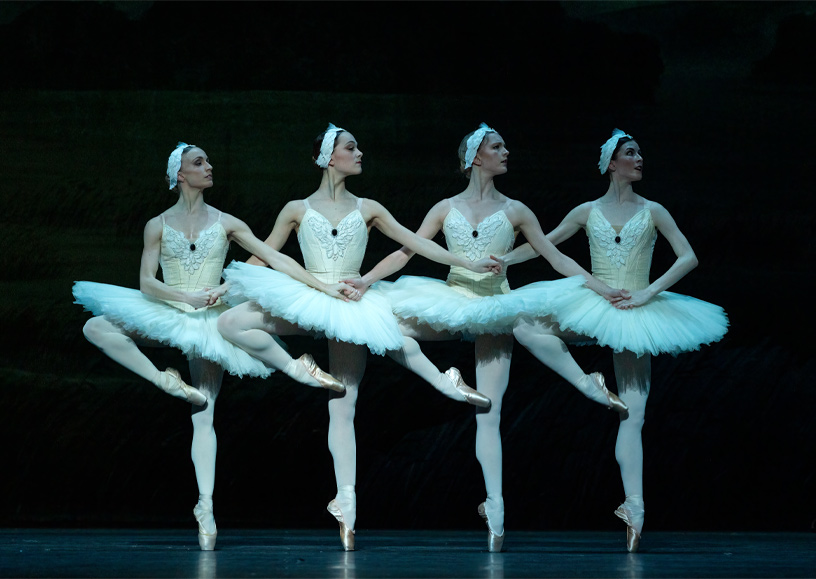
A swan’s skirt made of 10 square metres of tulle
An essential element in classical ballet and in Swan Lake: the tutu turns a corps de ballet into a harmonious group of elegant swans. But just how ‘classical’ is the tutu itself? And how are these iconic protruding skirts made? Oliver Haller, head of Dutch National Ballet’s costume department, talks about the nineteenth century and huge mountains of tulle.
“If the tutu didn’t exist, I might not be working here! Apart from the fact that it’s attached to a beautiful bodice, I’m also really fascinated by the tulle garment itself”, begins Haller passionately. “The tutu isn’t just any old ‘skirt’ – it’s taken the tutu at least a hundred years to reach its ultimate form, and there’s a great deal involved in the process of making them.” Although the tutu is seen as an absolute classic, it’s actually a much more recent invention than you might expect. “The tutu has only existed in its current form since around World War II. But before that, it already started its evolution at the beginning of the nineteenth century.”
NEW LACE, NEW OPPORTUNITIES
This evolution came about through an unintentional discovery. “In those days, people were crazy about lace. So a Mr Heathcoat from England wanted to develop a cheaper variety, but a flaw in his loom meant that he accidentally produced a new fabric. As he thought it was actually a very interesting material, he decided to manufacture more of it. And it became a real rage, which then crossed over to France as well. There, in the little town of Tulle, lots of lace makers decided to start using their machines for the production of this new fabric, which is how the material got its name.”
The invention of tulle opened up new possibilities for ballet costumes. Skirts made of the fabric were worn for the first time in 1831, in the production Robert le diable. “It was actually an opera, but the third act is viewed by some as the first ballet blanc: a scene where the principal ballerina and the corps de ballet of women are completely draped in white. This look became popular and the white tulle skirts were copied in many other ballets. However, these skirts were still very long, reaching right down to the ankles, as in those days no glimpse was allowed of the ballerinas’ legs, let alone their knees.” It was only when the role of the ballerina become more important and the dance steps demanded more leg room that the tutus were shortened – until eventually they reached the average length we see today.
SPECIALISM
The short tutus, as we still know them today, are technically very different from the original romantic tutu. “The basis is actually a pair of pants, onto which we sew more than ten square metres of tulle in total. They’re all straight strips, in gradually decreasing sizes. On our Swan Lake tutus, for example, the top strip is 40 centimetres wide and 6.5 metres long, the next is 38 centimetres wide and 5.5 metres long and the bottom layer is just 4 centimetres wide and 3.5 metres long. These strips are attached in turn around the girth of the hips, so that the straight pieces automatically form a circle.”

That may sound simple, but… “All that tulle has to be pulled under the foot of the sewing machine and sewn with very small stitches to gather it. So it’s a really big job, as well as a precise one. There are very few people in the world who can do it and who are really passionate about it – and I must say I’m very happy they exist! We had many of our tutus made by two English gentlemen who lived on a farm in Essex. Every morning, they got up early and didn’t go to bed again until each of them had finished another tutu. Specialists like them can make one tutu a day, but the process normally takes around 38 hours.”
REFINED COSTUMES
Although Dutch National Ballet’s production of Swan Lake premiered in 1988, many of the original – over three hundred – costumes are still used today. “Two series ago, we did have new tutus made, to which we attached the bodices from the old costumes. I had to give them a good soak beforehand – the dirt that came off them! – but they’re still really beautiful. Just like the rest of the costumes, they were made with the utmost care. All the decoration is very subtle and refined, and this style really reflects the character of Toer (van Schayk, the designer – ed.) as I know him. Some companies choose to work very obviously with feathers, but in our costumes they’re suggested in a more abstract way. For example, you can make out feather patterns, made of fabric and gold stitching, and there are a few more true-to-life feathers in the headdresses.”
RECENT ICON
And just as fine feathers make fine birds, so these detailed costumes are one of the things that make Swan Lake. “The image of the corps de ballet in white tutus is now fairly iconic for Swan Lake. Maybe also partly because all those layers of tulle resemble the downy layers of feathers on a swan. It appeals to the imagination and it remains a wonderful sight. Long legs, springy tutus and finely detailed bodices – ballet doesn’t get any more beautiful than that, does it?”
Text: Lune Visser